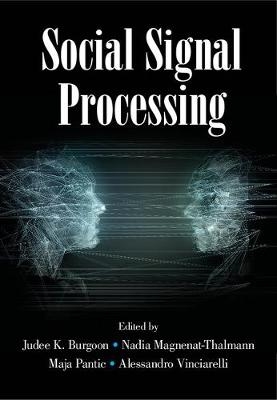
Social Signal Processing
Cambridge University Press (Verlag)
978-1-107-16126-9 (ISBN)
Social Signal Processing is the first book to cover all aspects of the modeling, automated detection, analysis, and synthesis of nonverbal behavior in human-human and human-machine interactions. Authoritative surveys address conceptual foundations, machine analysis and synthesis of social signal processing, and applications. Foundational topics include affect perception and interpersonal coordination in communication; later chapters cover technologies for automatic detection and understanding such as computational paralinguistics and facial expression analysis and for the generation of artificial social signals such as social robots and artificial agents. The final section covers a broad spectrum of applications based on social signal processing in healthcare, deception detection, and digital cities, including detection of developmental diseases and analysis of small groups. Each chapter offers a basic introduction to its topic, accessible to students and other newcomers, and then outlines challenges and future perspectives for the benefit of experienced researchers and practitioners in the field.
Judee Burgoon is Professor of Communication, Family Studies and Human Development at the University of Arizona, where she is Director of Research for the Center for the Management of Information. She has authored or edited fourteen books and monographs and more than 300 published articles, chapters and reviews related to nonverbal and verbal communication, interpersonal deception, and computer-mediated communication. The recipient of the highest honors from the International Communication Association and National Communication Association, she has been named the most published woman in the field of communication in the twentieth century. Nadia Magnenat-Thalmann has pioneered research into virtual humans over the last thirty years. Recently, she revolutionized robotics with her social robot, Nadine, who shows emotions and memory processes. She has received more than thirty awards and, besides directing her research group MIRALab at the University of Geneva, is presently Visiting Professor and Director of the Institute for Media Innovation (IMI) at Nanyang Technological University (NTU), Singapore. Maja Pantic is Professor of Affective and Behavioral Computing and leader of the i·BUG group at Imperial College London, working on machine analysis of human non-verbal behavior and its applications to human-computer, human-robot and computer-mediated human-human interaction. She has published more than 250 technical papers in machine analysis of facial expressions, machine analysis of human body gestures, audiovisual analysis of emotions and social signals, and human-centered machine interfaces. Alessandro Vinciarelli is Senior Lecturer (Associate Professor) of the School of Computing Science and Associate Academic of the Institute of Neuroscience and Psychology at the University of Glasgow. He has published more than 100 scientific works, has been principal or co-principal investigator on fifteen national and international projects, including the European Network of Excellence on Social Signal Processing. Vinciarelli has organized more than twenty-five scientific events and has co-funded a webcasting company, Klewel.
Introduction Alessandro Vinciarelli; Part I. Conceptual Foundations of Social Signal Processing: 2. What does it mean to be social? Kory Floyd and Valerie Manusov; 3. Universal dimensions of social cognition Cydney H. Dupree and Susan T. Fiske; 4. Measuring responses to nonverbal social signals Marianne Schmid Mast and Judith A. Hall; 5. Computational analysis of vocal expression of affect – trends and challenges Ross Buck, Mike Miller and Stacie Renfro Powers; 6. The vertical dimension of social signaling Klaus Scherer, Björn Schüller and Aaron Elkins; 7. Self-presentation Mark R. Leary and Katrina P. Jongman-Sereno; 8. Interaction coordination and adaptation Judee K. Burgoon, Norah E. Dunbar and Howard Giles; 9. Social signals and persuasion William D. Crano and Jason T. Siegel; 10. Social presence in CMC and VR Christine Rosakranse, Clifford Nass and Soo Youn Oh; Part II. Machine Analysis of Social Signals: 11. Facial actions as social signals Michel Valstar, Stefanos Zafeiriou and Maja Pantic; 12. Automatic analysis of bodily social signals Ronald Poppe; 13. Computational approaches for personality prediction Bruno Lepri and Fabio Pianesi; 14. Automatic analysis of aesthetics Hatice Guines and Björn Schüller; 15. Interpersonal synchrony Mohamed Chetouani, Emilie Delaherche, Guillaume Dumas and David Cohen; 16. Automatic analysis of social emotions Hatice Gunes and Björn Schüller; 17. Social signal processing for automatic role recognition Alessandro Vinciarelli; 18. Machine learning methods for social signal processing Ognjen Rudovic, Mihalis A. Nicolaou and Vladimir Pavlovic; Part III. Machine Synthesis of Social Signals: 19. Speech synthesis Kallirroi Georgila; 20. Body movements generation for virtual characters and social robots Aryel Beck, Zerrin Yumak and Nadia Magnenat-Thalmann; 21. Approach and dominance as social signals for affective interfaces Marc Cavazza; 22. Virtual reality and prosocial behaviour Ketaki Shriram, Soo Youn Oh and Jeremy Bailenson; 23. Social signal processing in social robotics Maha Salem and Kerstin Dautenhahn; Part IV. Applications of Social Signal Processing: 24. Social signal processing for surveillance Dong Seon Cheng and Marco Cristani; 25. Analysis of small groups Daniel Gatica-Perez, Oya Aran and Dinesh Jayagopi; 26. Multimedia implicit tagging Mohammad Soleymani and Maja Pantic; 27. Social signal processing for conflict analysis and understanding Alessandro Vinciarelli; 28. Social signal processing and socially assistive robotics in developmental disorders Mohamed Chetouani, Sofiane Boucenna, Laurence Chaby, Monique Plaza and David Cohen; 29. Social signal of deception and dishonesty Judee K. Burgoon, Dimitris Metaxas, Thirimachos Bourlai and Aaron Elkins.
| Erscheinungsdatum | 12.05.2017 |
|---|---|
| Zusatzinfo | 10 Tables, black and white; 20 Halftones, black and white |
| Verlagsort | Cambridge |
| Sprache | englisch |
| Maße | 185 x 260 mm |
| Gewicht | 1050 g |
| Themenwelt | Geisteswissenschaften ► Psychologie ► Sozialpsychologie |
| Geisteswissenschaften ► Psychologie ► Verhaltenstherapie | |
| Informatik ► Software Entwicklung ► User Interfaces (HCI) | |
| Informatik ► Theorie / Studium ► Künstliche Intelligenz / Robotik | |
| Technik | |
| ISBN-10 | 1-107-16126-6 / 1107161266 |
| ISBN-13 | 978-1-107-16126-9 / 9781107161269 |
| Zustand | Neuware |
| Haben Sie eine Frage zum Produkt? |
aus dem Bereich


